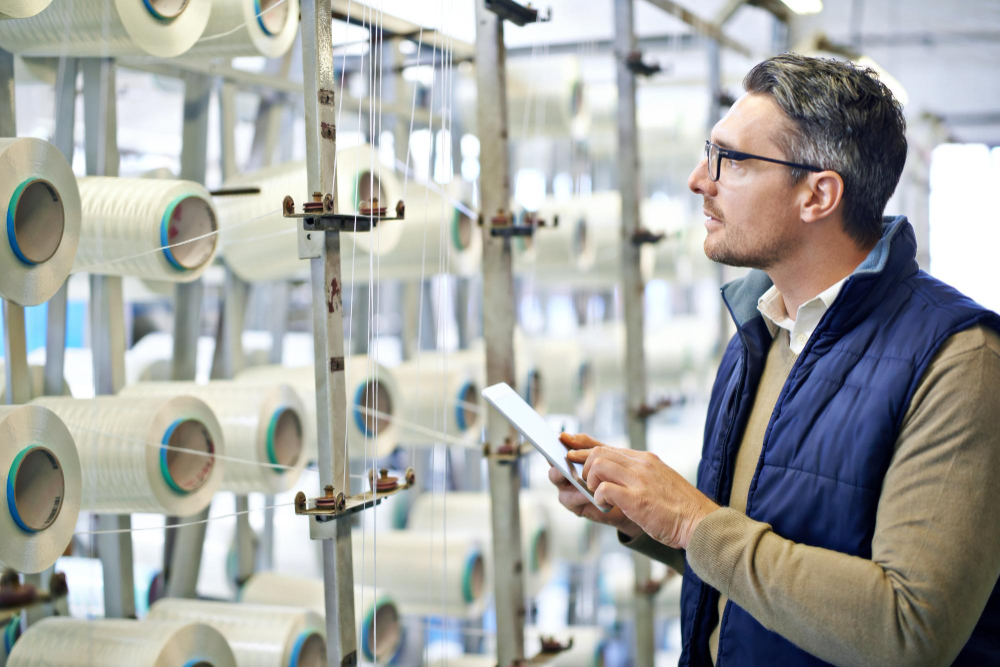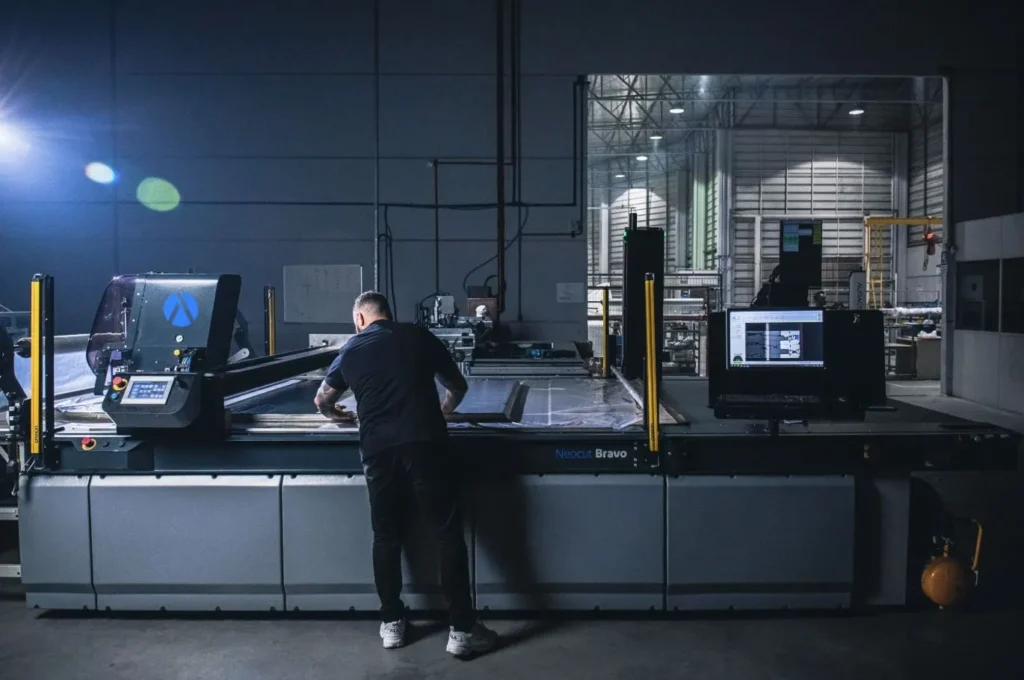Summary
- If you work in fashion manufacturing, your daily tasks may be more connected to textile engineering than you think.
- That’s because this field involves the design, development, and production of fabrics—key elements that shape fashion creation.
- Experience the future of the fashion industry with Audaces360. Start your free trial today!
As a production manager, you know how much happens behind the scenes before a garment is ready. But have you ever taken a closer look at what happens even earlier, at the textile level?
That’s where textile engineering comes into play. It’s the part of the process that transforms raw fibers into high-performance fabrics. And it impacts everything from product quality to production speed.
You don’t need to be an engineer to understand it. But knowing the basics can help you make smarter decisions on the floor. It can also open new possibilities for process improvement, cost savings, and innovation.
This article walks you through it, step by step. Happy reading!
Sumário
Why is it important to understand textile engineering?
Textile engineering is not just about making fabrics. It’s about improving how we make and use them in manufacturing garments. Understanding this area can help all fashion professionals make better decisions.
Knowing the basics of textile engineering can add real value to your career. You can help teams choose the right materials, reduce waste, and improve efficiency.
In textile manufacturing, engineering plays a major role. From fiber selection to fabric performance, many small details can have a big impact. A deeper understanding means fewer surprises and better results on the production floor.
It also opens the door to innovation. New fabrics, smart materials, and sustainable processes all come from advances in textile engineering. So, staying informed means staying ahead.
That’s why learning about this field can be really helpful. Whether you’re managing a team or optimizing processes, this knowledge can take your work to the next level.
What is textile engineering?
Textile engineering is the field that connects science and engineering with the world of fabrics. It involves studying fibers and how they turn into fabric. But it also goes further, looking at how to make the process smarter and more efficient.
This area is all about solving problems. Engineers here think about strength, comfort, durability, and even appearance.
A big part of textile engineering is developing fibers that meet specific needs. Some need to be soft and light. Others must be strong or resistant to heat. Engineers design and test these materials with clear goals in mind.
In the textile industry, this work supports everything from fashion to technical textiles. It helps make clothes that last longer, sportswear that performs better, and fabrics used in health care, cars, or space.
Learn more: How does technology in fashion impact the textile industry?
How does textile engineering work?

Textile engineering works by combining knowledge, technology, and creativity. It takes raw fibers and turns them into useful fabrics.
This includes choosing the right materials, using efficient machines, and applying smart techniques. Each step in the process matters and it all works together to create the final product.
Spinning and weaving processes
Spinning is the process that turns fibers into yarn. You can traditionally do it by hand, but with today’s technology, everything is done with machinery.
The goal is to create strong, even threads that are ready for weaving or knitting.
Weaving comes next. It’s the method of crossing yarns to form fabric. You can achieve it in different ways, depending on the type of fabric. It’s important to notice that the pattern and tension affect the fabric’s feel and strength.
Modern machines make spinning and weaving fast and precise. They help reduce waste and improve quality, and it’s the job of the textile engineers to choose the best settings for each fabric.
Finishing and treatment techniques
Once the fabric is ready, it’s time for the finishing step. It changes the look, feel, or performance of the fabric. The right finishing can make it softer, shinier, or more resistant to stains and wrinkles.
Common treatments include washing, bleaching, and dyeing. These steps add color or remove unwanted particles. Other techniques can add waterproof layers or improve stretching.
Textile engineers must choose the best finishing carefully. The wrong one can weaken the fabric or affect its safety. They also test the materials to see how they respond to different treatments.
Learn more: Understanding textile finishing and its different types
Quality control
Quality control is a key part of textile engineering. It makes sure the fabric meets the required standards, including checking strength, weight, and more.
It’s necessary to perform tests throughout the process. Some are visual, like spotting defects. Others use tools to measure thickness, stretch, or resistance. If something goes wrong, engineers fix it before production continues.
Good quality control saves time and money. It also protects the brand and builds trust with customers, as no one wants to deal with returns or complaints due to poor fabric.
Learn more: How can technology enhance the quality of textile products?
Sustainability and innovation
Today, textile engineering is not just about performance. It’s also about the planet. Many companies are rethinking their processes to reduce waste, save water, and use fewer chemicals.
Innovation plays a big part. Engineers are creating new ways to recycle fabrics and improve energy use. They are also working with existing materials to make them more eco-friendly.
Some are using natural dyes or biodegradable fibers. Others are turning plastic bottles into fabric. These ideas help the industry move toward a more sustainable future.
By combining smart design with care for the environment, textile engineering leads the way in both progress and responsibility.
Learn more: Smart uses of clean technology in clothing manufacturing
What does a textile engineer do?
A textile engineer works in many parts of the fabric production process. From choosing materials to managing factories, their role is wide and important. They solve problems, improve results, and bring new ideas to life.
Let’s look at everything their job really includes:
Material research and development
Textile engineers help create new materials. They study how fibers behave and what they can do.
Some fabrics need to be soft, while others need to be strong or flexible. It’s the engineers’ job to test many options until they find the best one. This part includes working in labs and using tools to test how fibers react to heat, water, or friction.
They also study how to mix natural and synthetic fibers. The goal is to develop materials that work well and are safe.
Production processes
Once the material is ready to go, it’s time to produce it. Textile engineering is responsible for designing and improving the steps that turn fibers into fabric. This includes spinning, weaving, knitting, dyeing, and more.
They choose the right machines and settings for each type of material. They also look for ways to speed up the process without lowering quality.
These professionals also work with production teams on the factory floor. They help solve problems when something goes wrong. In addition, they train staff in new methods or tools.
Want to take your company to the next level and reach peak productivity? Download our free exclusive guide filled with golden tips to get you there!
Quality management
Textile engineers also take care of quality. They create rules to check if a fabric meets the required standards, including size, color, strength, and safety.
They set up tests at different points in the process. If something is off, they act fast to fix it. That could mean adjusting a machine or changing a material.
They also write reports and keep records. This helps teams learn from mistakes and improve over time.
Industrial operations management
Textile engineering often requires some leadership knowledge. Professionals manage teams, organize shifts, and plan production schedules. Their job is to make sure everything runs on time and within budget.
They also watch how much material is actually necessary. If there’s too much waste, they work on solutions. This might involve changing processes or upgrading equipment.
Engineers also track performance data. They use it to find weak points and improve operations, making the factory more efficient and competitive.
Learn more: Discover the importance of textile equipment maintenance
Where can a textile engineer work?
Textile engineering offers many career options. Their skills are useful in different industries, not just fashion. They can work in factories, labs, startups, or even in offices doing audits and consulting.
Consider these as potential routes if you’re thinking about working in this field:
Textile and apparel industries
This is the most common field for textile engineers. They work in companies that make fabrics or clothes. The job is to make sure the materials meet quality standards and the production is efficient.
In these companies, they may help design fabrics or manage the machines. They also help test new materials and find ways to lower costs.
Automotive and aerospace industries

These industries also need special fabrics. Cars, planes, and spaceships use strong, light, and safe materials. Textile engineers help develop and test them.
In the automotive world, they may work on seats, airbags, or insulation. In aerospace, they might help create heat-resistant fabrics or lightweight parts.
Engineers must follow strict safety rules in these industries. Their work has to be both smart and precise.
Learn more: 4 advantages of technology in automotive furniture design
Research and innovation labs
Textile engineers can work in labs that focus on innovation. These labs may be in universities, companies, or public institutions. The goal is to explore new uses for textiles and improve existing ones.
In this setting, engineers test ideas that are not yet ready for the market. They may work with nanotechnology, smart fabrics, or eco-friendly dyes.
They run experiments, write reports, and sometimes publish studies. It’s a mix of science and creativity.
Tech and sustainability startups
Many startups are looking for new ways to make the textile world more efficient and sustainable. In this scenario, textile engineers are key to turning bold ideas into real solutions.
They might work on digital tools for fabric tracking, recycling systems, or new plant-based materials. These jobs are often fast-paced and full of learning.
Here, engineers must know how to perform multiple roles. One day they might be testing a new fiber, and the next, helping prepare a pitch for investors.
Consulting and auditing for textile certifications
Consultancy in textile engineering helps companies meet international textile standards. This includes checking if products are safe, eco-friendly, or made under fair conditions.
They visit factories, analyze processes, and write detailed reports. Their work helps brands earn certifications like OEKO-TEX or GOTS.
This job requires a sharp eye and strong communication skills. It also involves staying updated on laws and best practices.
Rely on the best of Audaces engineering

Audaces Cutting Room
By embracing cutting-edge technology, garment manufacturers can achieve significant improvements in the production process. From greater design flexibility to enhanced efficiency and reduced costs.
This is where Audaces Cutting Room steps in! Our experts will thoroughly assess your company’s needs and create a comprehensive report.
Then, our team will develop a personalized project to achieve your goals and unlock your company’s full potential.
Rely on Audaces’ cutting-edge machinery to automate your production process. Achieve impeccable cuts on curves and details, speeding up your deliveries and minimizing fabric waste through automation.
Was this article helpful? Get our latest content first by subscribing to the Audaces newsletter!
FAQ
Textile engineering is not just about making fabrics. It’s about improving how we make and use them in manufacturing garments. Understanding this area can help all fashion professionals make better decisions.
Textile engineering is the field that connects science and engineering with the world of fabrics. It involves studying fibers and how they turn into fabric. But it also goes further, looking at how to make the process smarter and more efficient.
Spinning and weaving processes, finishing and treatment techniques, quality control, sustainability and innovation.





